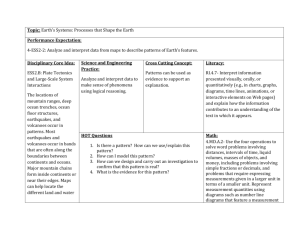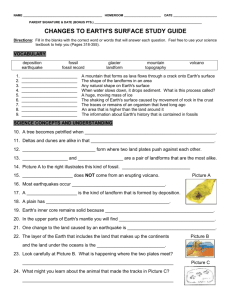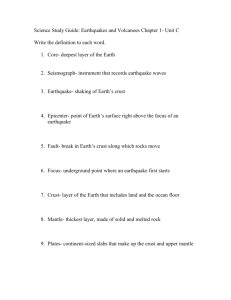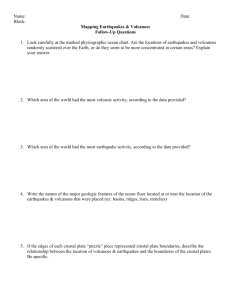MAPS-GIS - Plate Tectonics
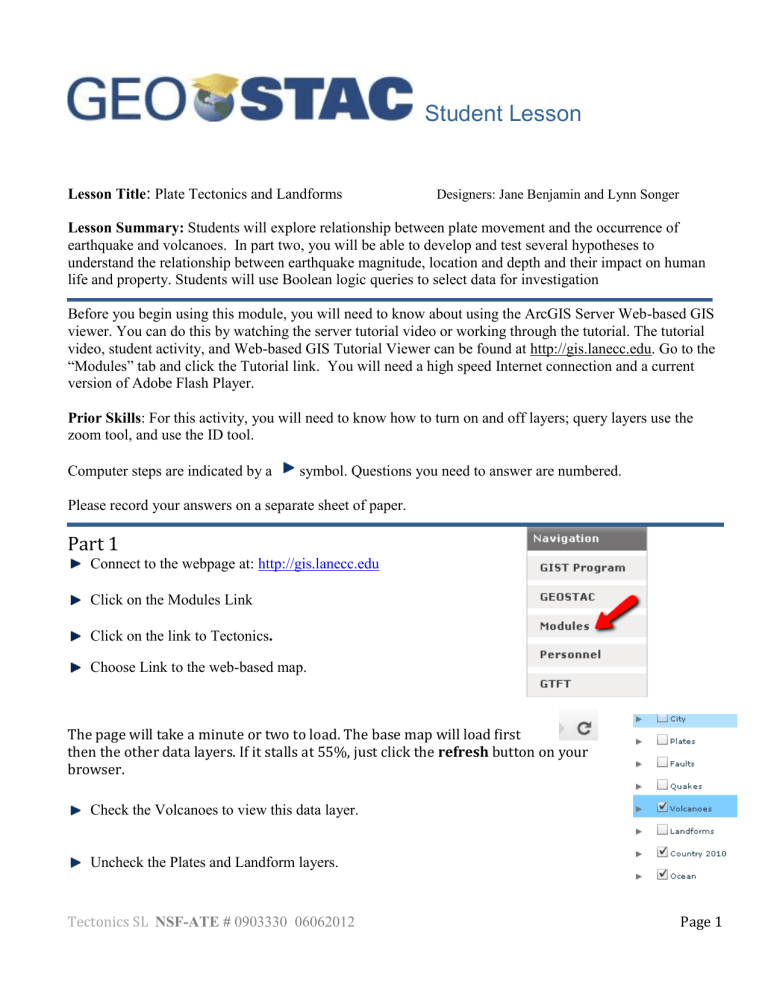
Student Lesson
Lesson Title
:
Plate Tectonics and Landforms Designers: Jane Benjamin and Lynn Songer
Lesson Summary: Students will explore relationship between plate movement and the occurrence of earthquake and volcanoes. In part two, you will be able to develop and test several hypotheses to understand the relationship between earthquake magnitude, location and depth and their impact on human life and property. Students will use Boolean logic queries to select data for investigation
Before you begin using this module, you will need to know about using the ArcGIS Server Web-based GIS viewer. You can do this by watching the server tutorial video or working through the tutorial. The tutorial video, student activity, and Web-based GIS Tutorial Viewer can be found at http://gis.lanecc.edu. Go to the
“Modules” tab and click the Tutorial link. You will need a high speed Internet connection and a current version of Adobe Flash Player.
Prior Skills : For this activity, you will need to know how to turn on and off layers; query layers use the zoom tool, and use the ID tool.
Computer steps are indicated by a symbol. Questions you need to answer are numbered.
Please record your answers on a separate sheet of paper.
Part 1
Connect to the webpage at: http://gis.lanecc.edu
Click on the Modules Link
Click on the link to Tectonics .
Choose Link to the web-based map.
The page will take a minute or two to load. The base map will load first then the other data layers. If it stalls at 55%, just click the refresh button on your browser.
Check the Volcanoes to view this data layer.
Uncheck the Plates and Landform layers.
Tectonics SL
NSF-ATE # 0903330 06062012
Page 1
1) Describe the spatial occurrence of volcanoes in relationship to the continents. Spatial occurrence means the spatial arrangement , distribution patterns and location of a geographic feature. Are patterns dispersed
(spread out evenly)? Are they clustered (clumped or grouped)? Are they linear (in a line ) ? Or are they random (no identifiable pattern)? Spatial occurrence also refers to the location in relationship to other features.
Right click the Volcanoes data layer and choose to open the Attribute Table.
2) List the attribute data that is available for the Volcano data layer?
Uncheck Volcanoes and check Earthquakes.
3) Describe the spatial occurrence of earthquakes in relationship to the continents.
4 ) How is the spatial distribution or patterns of earthquakes and volcanoes similar or different?
5 ) Turn on “ Plates
”. What is the relationship between plates and earthquakes and volcanoes?
Look at the printed map below showing generalized plate movement (see red arrows).
6 ) List two examples of plates that are diverging – moving away from each other - and give the directions they are moving.
Turn on the Earthquake and Volcanoes layers on the web-based GIS map.
Tectonics SL
NSF-ATE # 0903330 06062012
Page 2
7) What is the dominate event type - volcano or earthquake – along divergent plates?
8) List two examples of plates that are converging and give the directions they are moving.
9 ) What is the dominate event type - volcano or earthquake – along convergent plates?
Turn off the Earthquake and the Volcanoes layer.
Turn on the Landform layer and the Plates layer.
Expand the Landform legend.
You will use the query option to select and highlight three types of fault area
– Transform, Divergent, and Convergent. Each fault type creates specific landforms.
It will be easier to see the selection if you turn off the Landform layer before you start the query.
First Query the Convergent fault areas.
Right click Landforms and choose
Query Layer.
When the Query Builder opens
Double click type to add it to the query string.
Click the = sign.
Click Get Unique Values and double click Convergent.
This process will create a query string (statement or equation) in the query builder.
Choose OK
10) Describe the general location of convergent landforms. Are they on plate boundaries, edges of continents, middle of land masses, along plates …
Clear the selected features.
Create a new query. This time select Divergent from the Get Unique Values.
11) Describe the general location of divergent landforms. Are they on plate boundaries, edges of continents, middle of land masses, along plates?
Clear your selection.
Create a new query. This time select Transform from Get Unique Values.
Tectonics SL
NSF-ATE # 0903330 06062012
Page 3
12) Describe the general location of transform landforms. Are they on plate boundaries, edges of continents, middle of land masses, along plates?
The Andes Mountains and the Cascade Mountains were formed (are being formed) as a result of sea floor plates converging with continental plates. This special convergent boundary is called a subduction zone.
Follow the directions to create a query that will select both these mountain areas.
Right click Landforms
Query Layer.
Create the following advanced query statement. You will need to have a complete query statement for each feature you want to select. The statements will be joined with the OR operator.
Name = Andes mountains OR Name = Cascade Mountains.
OK
13) Why should you use OR and not AND for this statement?
Turn on Volcanoes and then turn on Earthquakes.
14) What is the association between Volcanoes and Earthquakes and subduction areas?
Check City.
Query the City layer to select the Capital cities.
Enter this statement - Capital = ‘Y”
Zoom in to the west coast of South America.
Use the ID tool and click the selected cities that are in the convergent landform area of the subduction zone.
15) Fill in the table below.
Country and Capital Name Population
16) Based on your preliminary inquiry, why is it important to understand the geography of convergent plate movement? What government and municipal agencies should understand the geographic relationships of plate movement and population?
Part 2
In this lesson you will explore the relationship between death and several variables associated with
Tectonics SL
NSF-ATE # 0903330 06062012
Page 4
earthquakes and the variability in earthquake magnitude. There are 3172 earthquake records in this data layer. They represent significant earthquakes from 2150n B.C. to 2009.
Deaths from earthquakes in this data set range from 0 to 1,100,000.
Query all quakes with deaths greater or equal to 70000.
1) Describe the pattern of the selected feature. Where are they located?
2) Recorded your hypothesis related to the following
Magnitude and high death rates.
Mercalli scale and high death rates.
Depth of quake and high death rates.
Tsunami occurrence and high death rates.
Year of occurrence and high death rates.
Click the MAG Field to sort it. This is the Richter Magnitude scale.
3) What is the highest and the lowest magnitude recorded here?
4) Is there a strong relationship between MAG and death? Hint: You can drag the MAG field beside the
Death field so it will be easy to compare.
Sort by Mercalli Field. This represents the Mercalli scale
5) Describe the relationship between the Mercalli scale and death.
Sort by Year.
6) Describe the relationship between Year and death. What might explain this relationship?
Sort by Tsunami.
7) Describe the relationship between tsunami occurrence and death.
Turn off the Quake layer. Your data will still be selected and highlighted. Zoom in to the selected points in
Asia first.
8) What can you say about the location of these killer events and their relationship to plate boundaries?
Tectonics SL
NSF-ATE # 0903330 06062012
Page 5
9) Look at the data you collected and compare it to your hypotheses. Discuss your data findings. What statements can you support regarding earthquakes and human impacts?
10) A puzzle. This chart shows two high magnitude quakes in Antakya Turkey – one in the year 525 the other three years later in 528.
11) Discuss some reasons there was less loss of life from the 528 quake even though it had a higher magnitude and a higher Mercalli scale?
NAME
TURKEY: ANTAKYA (ANTIOCH),
TURKEY: ANTAKYA (ANTIOCH)
Career Extension
4 250000
4 4870
36.25
36.25
36.1
36.1
7 9 525
7.1 10 528
Go to the website: http://www.esri.com/industries.html
Find a career that might be of interest to you. For example, in the Natural Resources list there is a link to
Forestry. In the forestry link there are several job descriptions in the Industry Focus.
Prepare a half-page summary of the types of things that someone would do in this career using GIS.
Search the Internet and look for job possibilities, salary, and locations.
Tectonics SL
NSF-ATE # 0903330 06062012
Page 6



